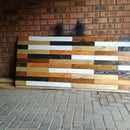Introduction: Reclaimed Wooden Workbench
Our garage looked a bit empty at the front, plus my girlfriend and I had a build project coming up and I decided a work bench was needed. We don't have a big garage so I opted for a folding workbench to save space. (Turns out the car fits in the garage even with the workbench stood up, so no need to drop it down after working).
The wood was sourced from a wooden box picked up from a dumpster, I think it's Pine.
The image above served as some inspiration as well as the video.
I am sorry for not mentioning everyone that served as inspiration for my own workbench.
Step 1: Planks
The wooden box was broken down into individual planks. The width averaged around 190mm with the length around 1100mm.
The one board had an extra piece of wood nailed in to create a wider plank.
Step 2: Rough Layout
For the rough layout I just laid everything down on the grass to get a sense of how everything will fit together. The first idea was to use the wider board for the wall mount support, but in the next step I swapped it out for one less wider.
Step 3: Leg Supports
Close-up of the leg supports layout.
Basically I have a leg support where the folding leg would be attached with hinges. A cross piece was added at 45 degree angle for extra strength.
Step 4: Work Top Finished
Here the work surface was fastened to side supports with normal wood screws.
Step 5: Layout of Leg Hinges
Because I wasn't sure if the car will fit in the garage I opted for a folding bench. The pictures shows were the hinges will be placed to fold the legs closed.
Step 6: 45 Degree Angle Support Glue & Screw
The angled support was to be glued and screwed into place with wood screws, but I struggled to get the cross support clamped properly. In the end I got it done, even though it looks a bit hectic.
Step 7: Folding Leg Attached
In this photo the hinges are attached to the leg and support structure in the closed position.
Step 8: Work Surface Mount to the Wall Support Structure
I had the rough layout for where the large hinges will have to be mounted, they overlap slightly on the leg hinges but that's not a big deal.
The middle support was added for extra strength, I wasn't sure if the work bench planks would buckle under some pressure from working. I made a mistake with the position on the inside of the work bench where the legs meet and had to trim down to an angle to allow for everything to close snugly.
Step 9: Mounted
The workbench finally mounted and everything seems to be working fine.
It was mounted with 10mm coach screw and wall plugs straight into the brick. At the bottom of the leg there is also a wall support for when you press down that the legs also sits flush against the wall.
Step 10: Final Product
The makeshift handle was removed because it was in the way a little too much for my liking, which I think made the overall look much better.
On the leg support for the work surface we mounted the sliding lock which was not originally planned. I had them left over from another project. A small hole is drilled into the leg support where the lock slides into, just to hold everything in place. I wasn't sure if the legs would move out by accident while working so this helps for that.
As you can see the wall profile is only 80mm in the closed position which makes for a great space saver.

Participated in the
Reclaimed Contest 2017












